Brendan Rodgers’ time at Celtic has brought a fresh and exciting tactical approach that transformed the team’s style of play. Known for his emphasis on possession, high pressing, and fluid attacking football, Rodgers has implemented a system that allows Celtic to dominate opponents domestically and in Europe. This tactical analysis explores the key elements of his strategy, from formation choices to pressing patterns, and highlights how Rodgers’ philosophy is shaping Celtic’s recent success. Dive into the intricate tactics that make Celtic a force to be reckoned with under Brendan Rodgers.
Build-up
Low Build-up
In the low build-up, Rodgers sets his team up in a 1-4-3-3 formation with a back four, one number-six, two number-eights, and a front three.
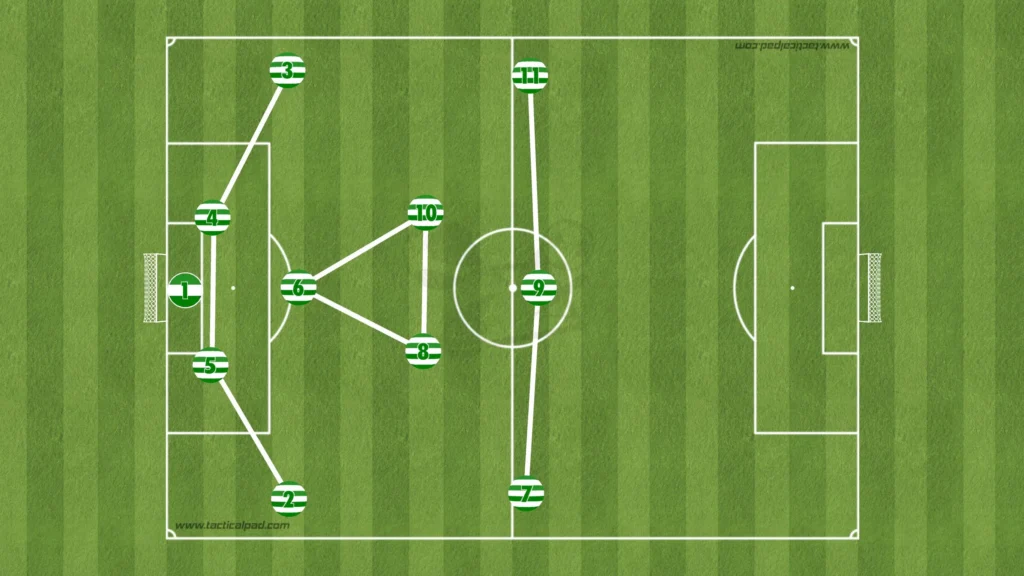
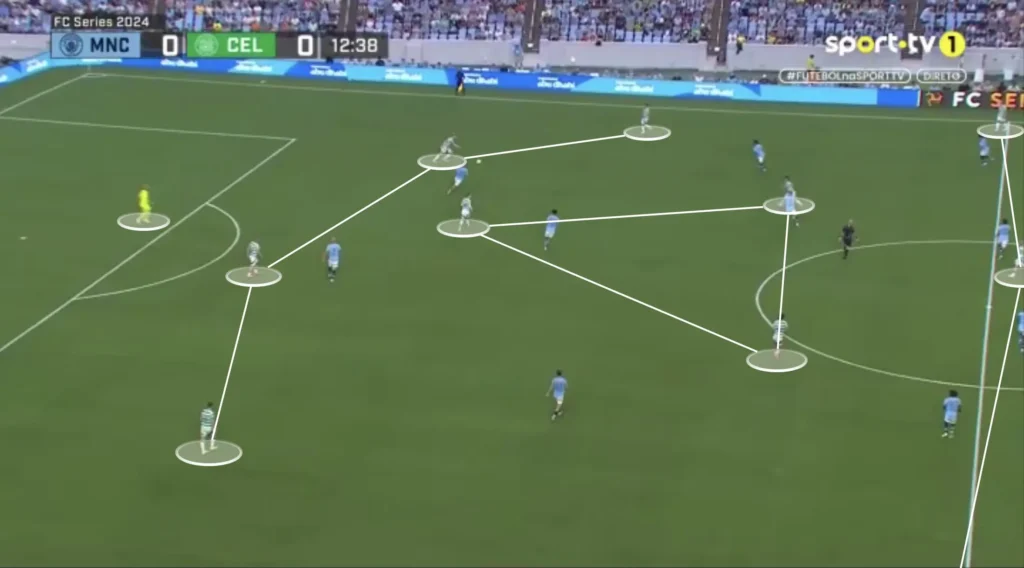
They often drop with the central midfielders and like using the goalkeeper, which creates numerical superiorities lower down the pitch, allowing them to beat the press. When Celtic beat the press, the attackers will immediately make runs in behind, looking to quickly exploit the holes in the opposition’s backline.
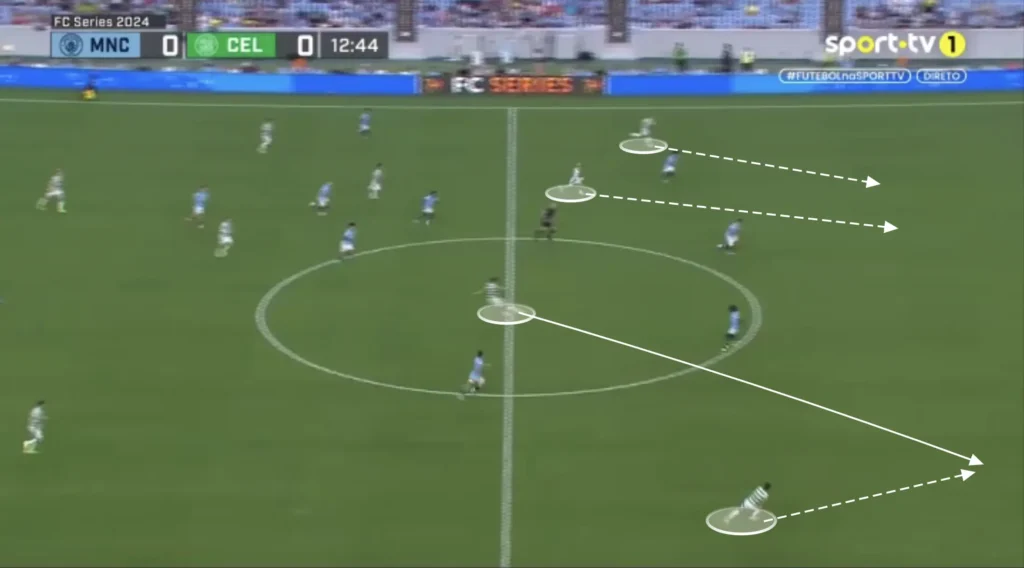
High Build-up
In the high build-up, the Celtic fullbacks invert into the midfield. They will come into the midfield next to the number-six, with the wingers staying as wingers and the number-eights pushing up as the attacking midfielders.
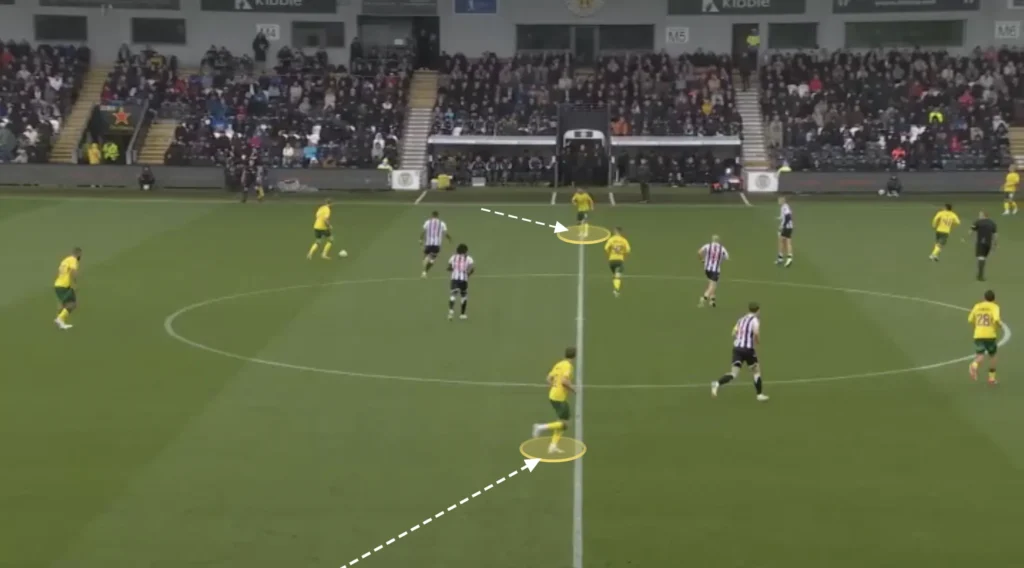
This creates a 1-2-3-2-3 structure:
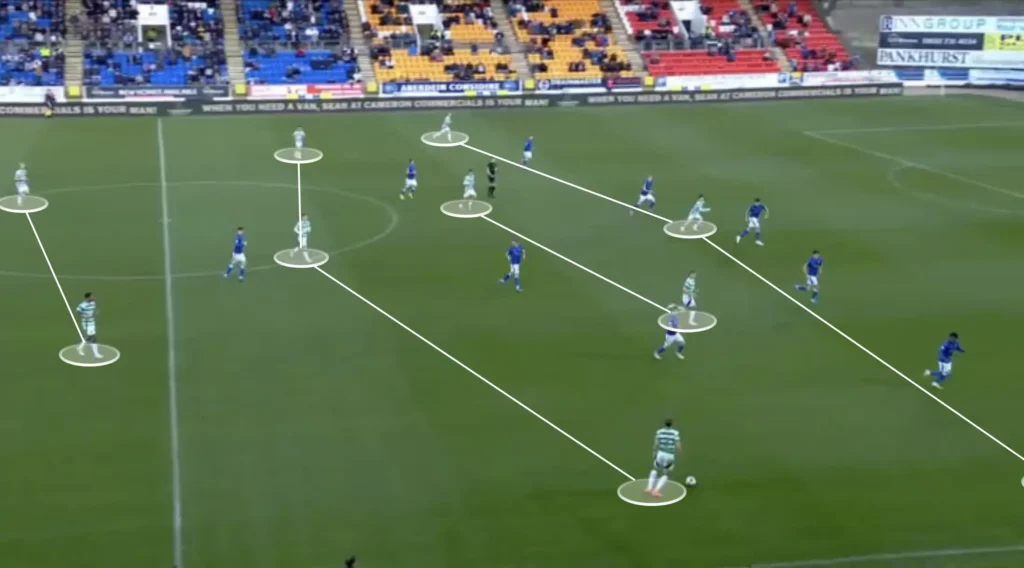
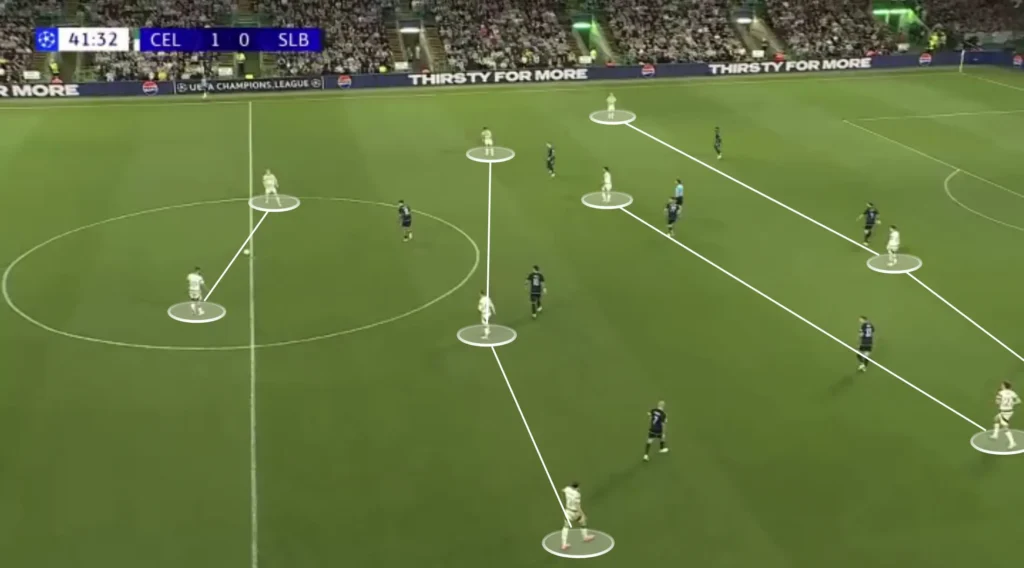
The 1-2-3-2-3 formation allows for a strong presence in the midfield, which helps in controlling the game and dictating the tempo. The two central defenders provide a solid foundation for recycling possession, while the three holding midfielders can effectively link play between defense and attack. The three forward players stretch the opposition’s defense, creating space for the attacking midfielders, who move around, trying to create overloads in key areas.
Additionally, when the fullbacks invert, the opposition wingers usually follow to cover the run, which opens the passing lane from the center-back to the winger. The center-back can play the ball to the winger, who can attack the opposition fullback and combine with the number-eight to create a 2v1 situation.
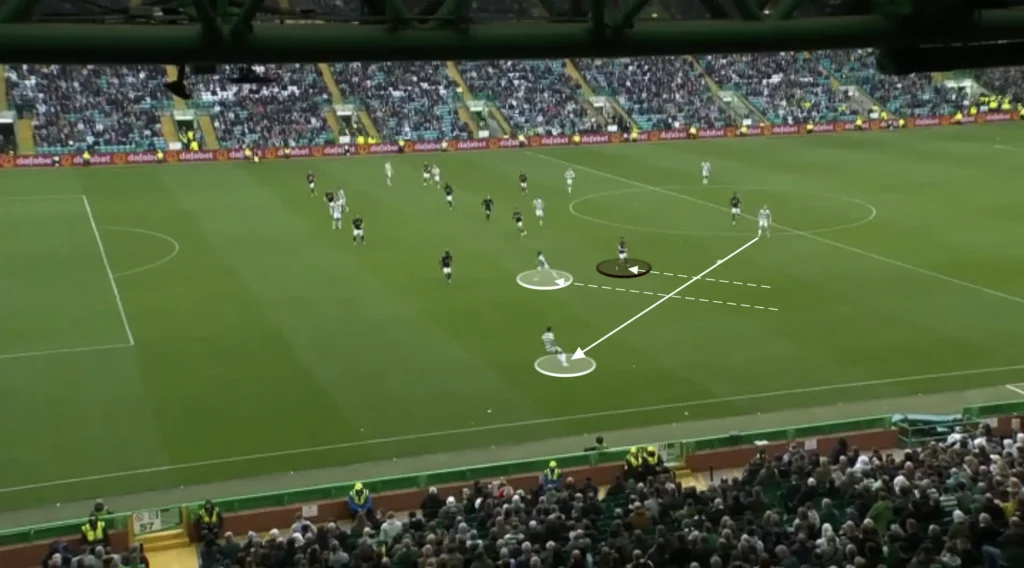
Numerical Advantage in the midfield
Having only the two wingers out wide and the rest of the players in the middle creates more options in the center and less space between the players. Rodgers likes this because he prioritizes playing through the middle. He needs one player out wide to pull the opposition apart while the rest create numerical advantages in the midfield areas. When a team outnumbers the opposition in the midfield, it can more easily retain the ball, exploit spaces, and progress the ball through the center. Celtic will often progress the ball through quick central passes between the midfielders, beating the opposition’s press and exploiting gaps in the defense. At the same time, having many players centrally builds good conditions in defensive transitions since it allows more players to counterpress when they lose the ball.
Another purpose for keeping many players in the middle is to shorten the distance between them. This shortens the length of the passes, which naturally shortens the time between passes. This means the opposition players will have less time to push up and press, giving the Celtic players more time and control.
Rest-Defence
Rodgers also wants many players close to the center to create a good rest-defence structure. A good rest-defence structure is crucial for maintaining balance and preventing counterattacks when the team is in possession. Having many players in the middle builds good conditions in defensive transitions, allowing more players to counterpress when losing the ball. The two center-backs and three holding midfielders form the core of the rest-defence, as they are well-positioned to deal with any potential loss of the ball. When losing possession, the four or five Celtic players closest will immediately jump on the opposition player with the ball and close the distance to cut off any passing lanes. This approach disrupts the opponent’s transition from defense to attack, forcing errors and creating opportunities to regain control of the ball.

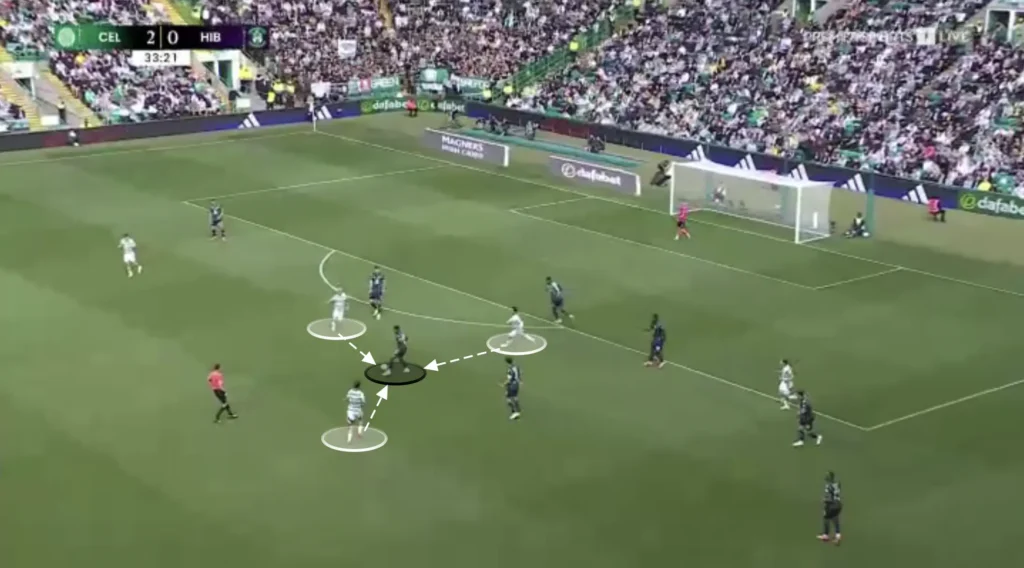
Counterpressing like this keeps Celtic on the front foot, allowing them to dominate possession and create more scoring opportunities. However, it requires exceptional fitness, tactical discipline, and teamwork.
Fluidity
Celtic’s fluidity in the build-up under Brendan Rodgers has been a key aspect of their tactical evolution. The team often adopts a dynamic approach, shifting between formations to create numerical advantages and exploit spaces. Rodgers’ focus is always to get the players into their best positions, where they can make the most out of their individual skills. He emphasizes versatility, with players interchanging positions seamlessly to maintain possession and disrupt the opposition’s defensive structure. Celtic’s most frequent rotation is when the attacking midfielder and inverted fullback switch places to pull their defenders away and create more space and confusion.
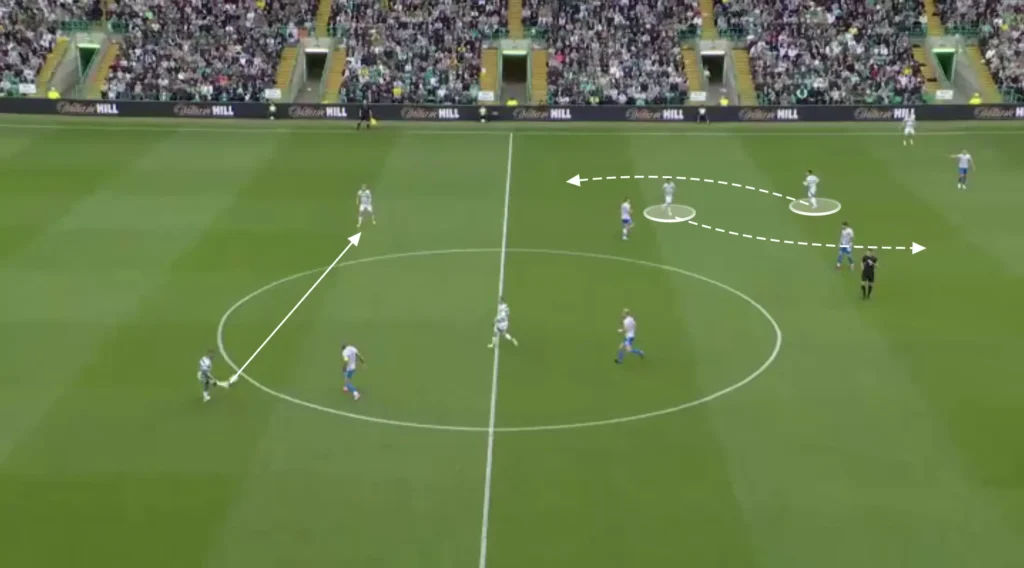
The fullbacks can also come up next to the attacking midfielders, creating a 1-2-1-4-3 formation.
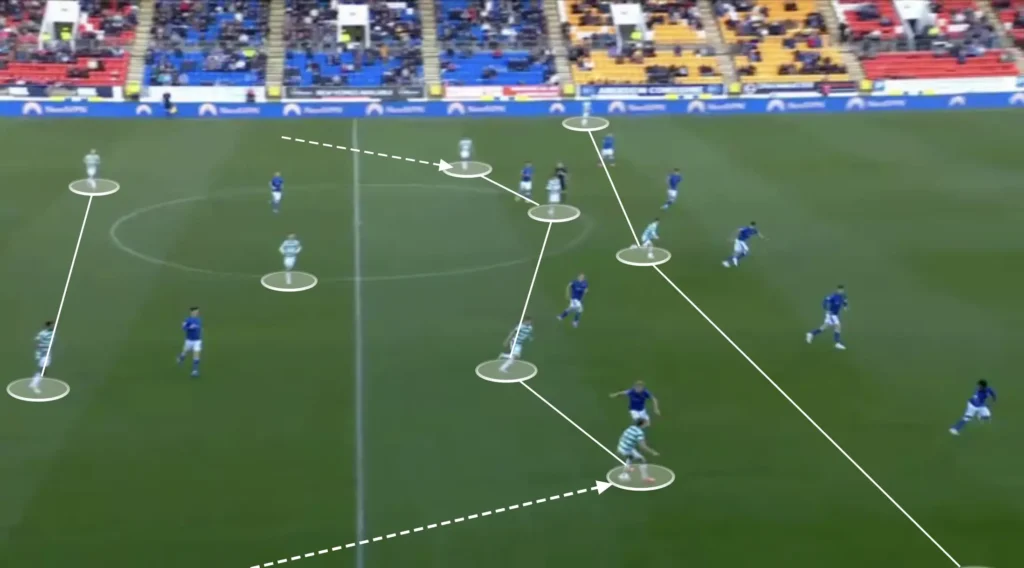
This rotation often gives Celtic’s attacking midfielder and inverted fullback 2v1 situations against opposition midfielders. Celtic will use these 2v1 situations to beat the opposition’s defense and progress the ball into the final third.
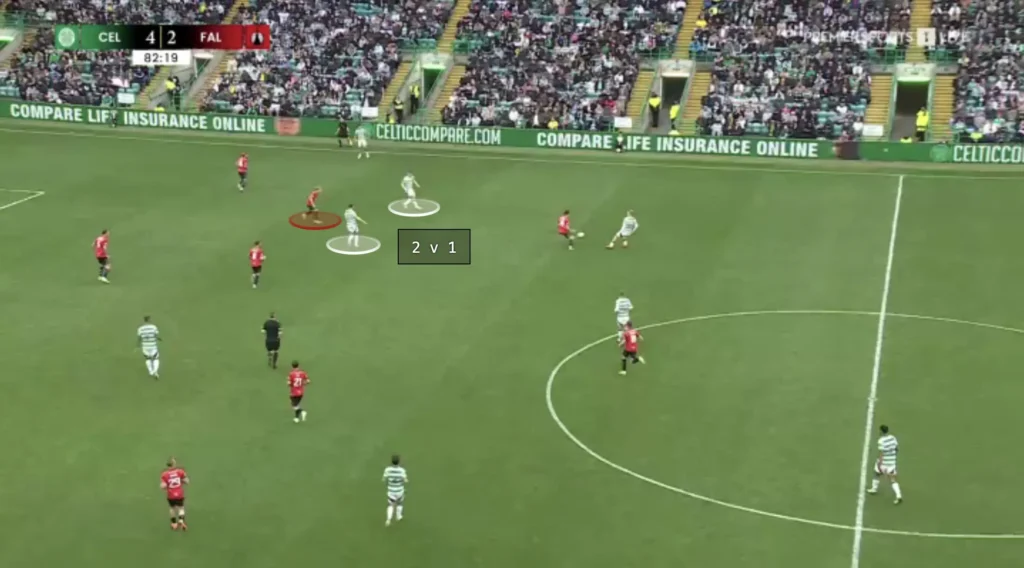
While it demands a lot of technical and tactical skills from the players, this fluidity has created new dynamics for Celtic’s attacking style, offering new solutions and ways of beating the opposition’s press. It enhances their ability to control the game while opening up opportunities for incisive passes and creative plays.
Using the Goalkeeper
Brendan Rodgers likes using the goalkeeper in the build-up. Celtic’s goalkeeper, Schmeichel, will often push up between the center-backs, giving Celtic an extra man in the build-up phase.
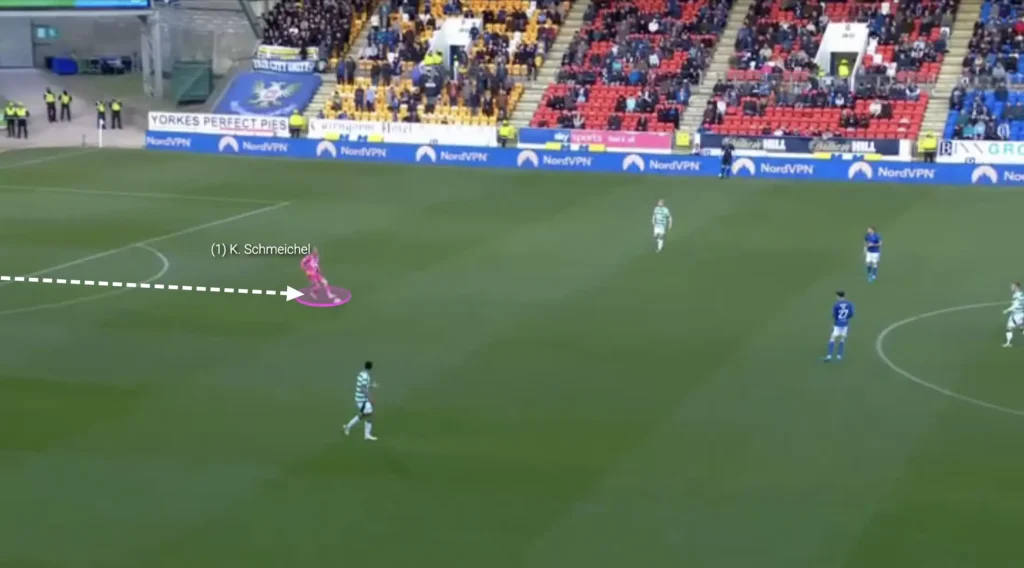
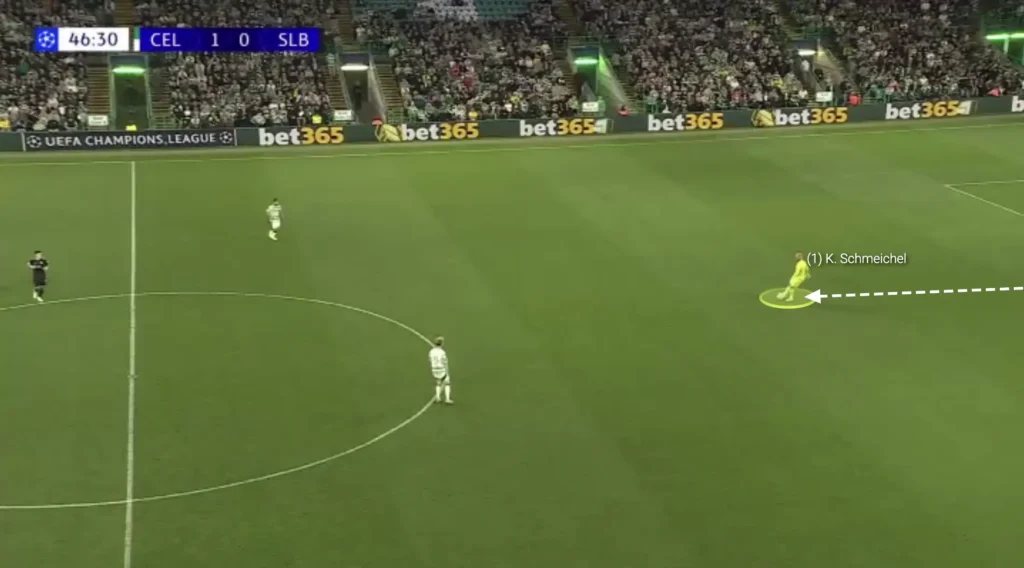
Using the goalkeeper in the build-up phase offers numerous tactical advantages. By involving the goalkeeper, Celtic can create numerical superiority at the back, making it easier to evade the opponent’s press and maintain possession. This additional player allows for more passing options, reducing the risk of losing possession and enabling smoother transitions from defense to attack. The goalkeeper can also act as a pivot, switching play across the field to exploit weak points in the opposition’s formation. Furthermore, involving the goalkeeper helps in drawing the opposition forward, creating space higher up the pitch for attackers to exploit.
Additionally, with the goalkeeper pushing up, the center-backs can come wider.
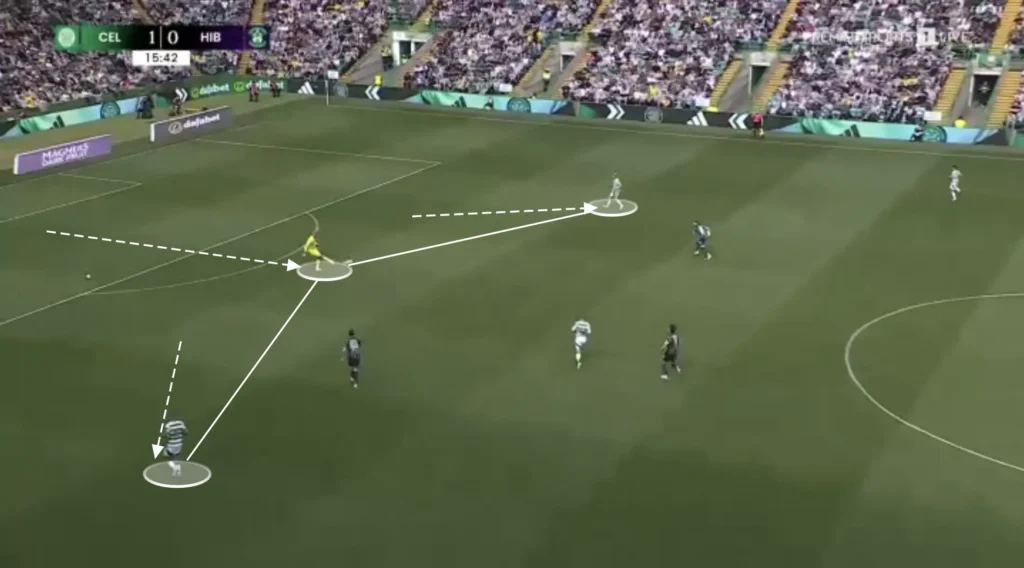
When the center-backs come wider, they can take the ball forward when receiving it to break the opposition’s first line of pressure. This provides a safe and easy way for Celtic to break the opposition’s first line and progress the ball up the pitch.
High Backline
A massive aspect of Rodgers’ high possession build-up is to have the defenders high up. This helps in the counterpress because they get closer to the midfield. Having more players close to the center who can win the ball back makes it difficult for the opposition to do anything when they win possession. Furthermore, the high backline shortens the distance between players, shortening the time and length of the passes and preventing the opposition from pushing up their defense.
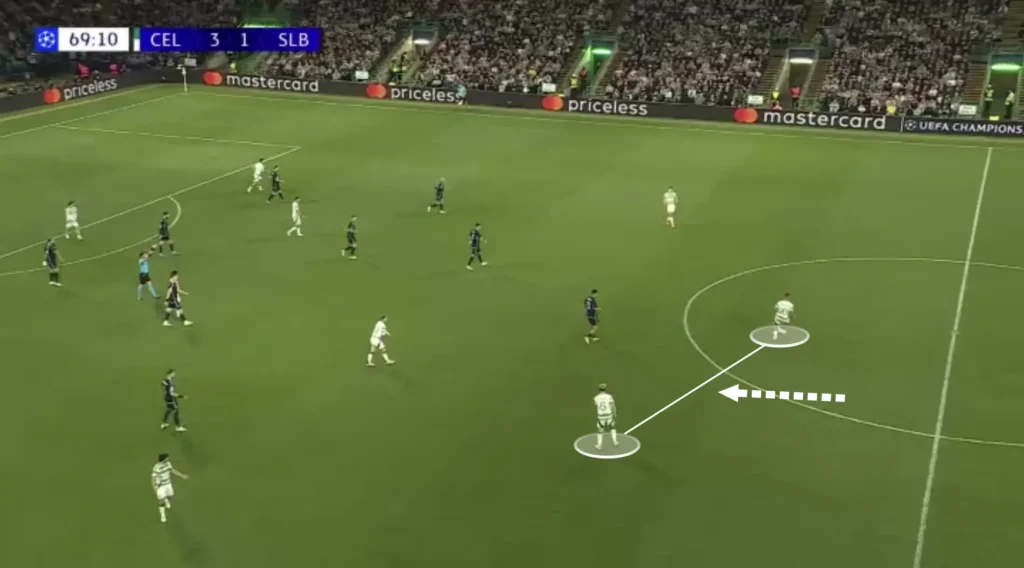
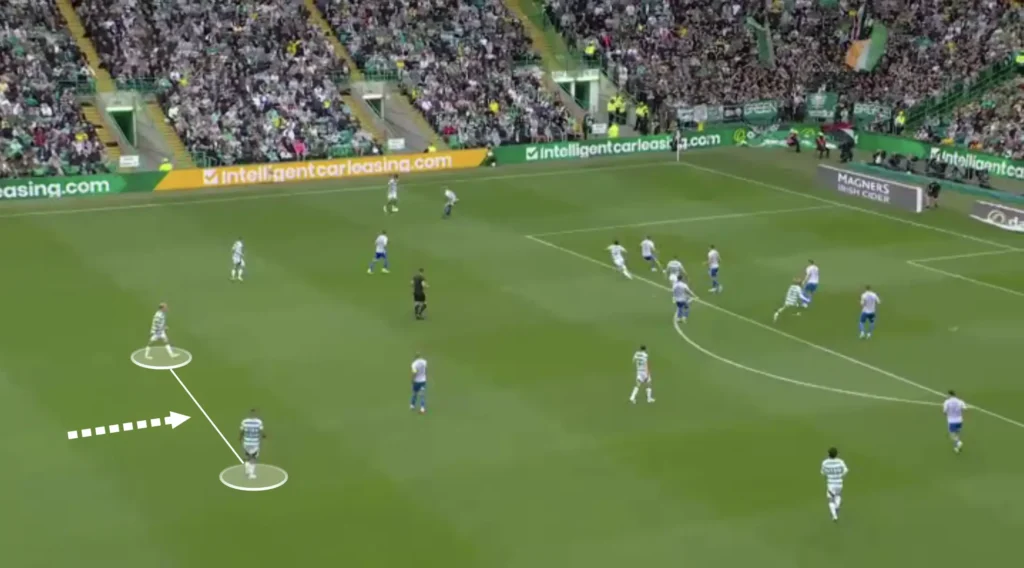
Finding the Pockets
Rodgers’ players always try to find the attacking midfielders in the pockets. These “pockets” refer to the spaces between the opposition’s defensive and midfield lines, where the attacking midfielders can receive the ball in more advanced positions.
By positioning themselves intelligently in these pockets, the attacking midfielders can turn quickly and face the opposition’s goal, creating opportunities for through balls, driving runs, or direct shots. This positioning forces the opposition to make difficult decisions. If an opposition defender steps up and closes down the attacking midfielder, he potentially leaves space behind. If he stays back, he allows the midfielder time on the ball. The Celtic defenders and holding midfielders will look for straight passes, breaking the opposition lines and finding the attacking midfielders who can turn and drive at the defense.
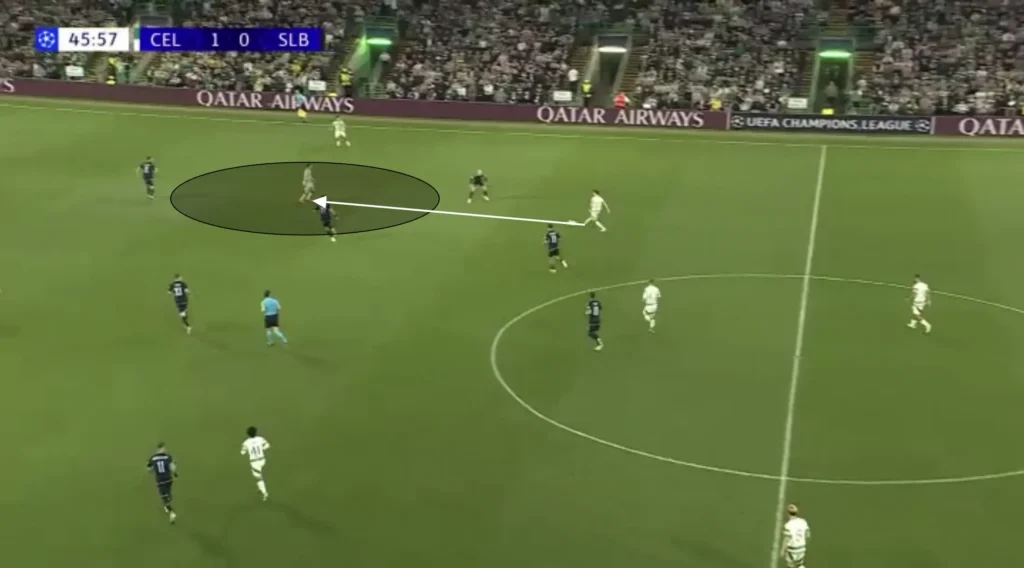
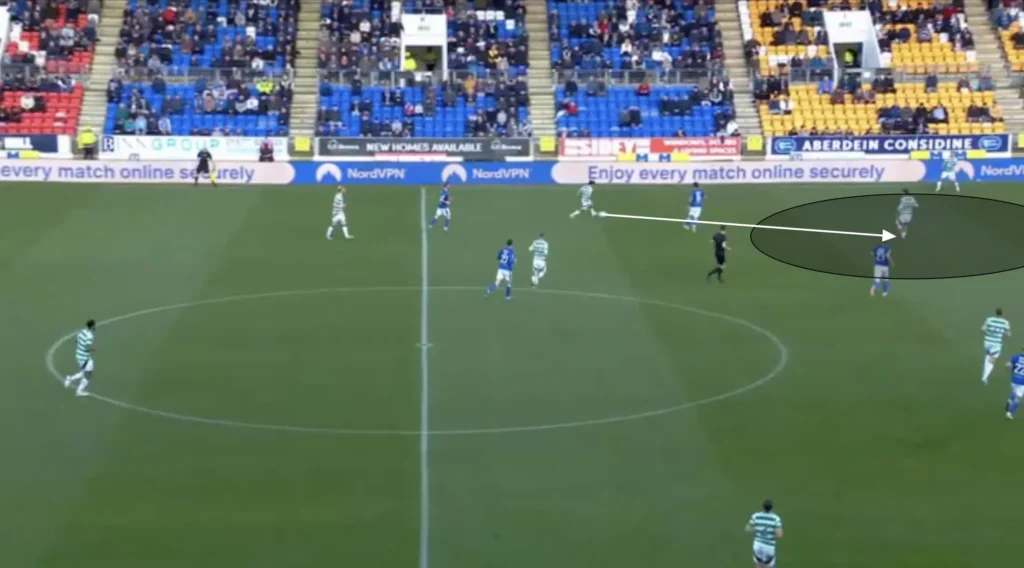
Finding these pockets is crucial for maintaining fluidity in attack and ensuring that the team can progress the ball effectively through the middle of the pitch.
Dropping Outside
When the opposition defends very compactly and does not allow the attacking midfielders to be found in the pockets, Celtic’s attacking midfielders can drop outside to receive the ball there instead. They will wait for the opposition’s wide midfielders to come into the middle and drop out into the space outside of them. The opposition center-backs and central midfielders rarely follow these runs, not wanting to open the space in the center. Additionally, the winger, who is positioned high and wide, will be pinning the opposition fullback, not allowing him to jump on the dropping attacking midfielder. This means that the attacking midfielder can receive the ball, turn, and progress the ball unopposed.
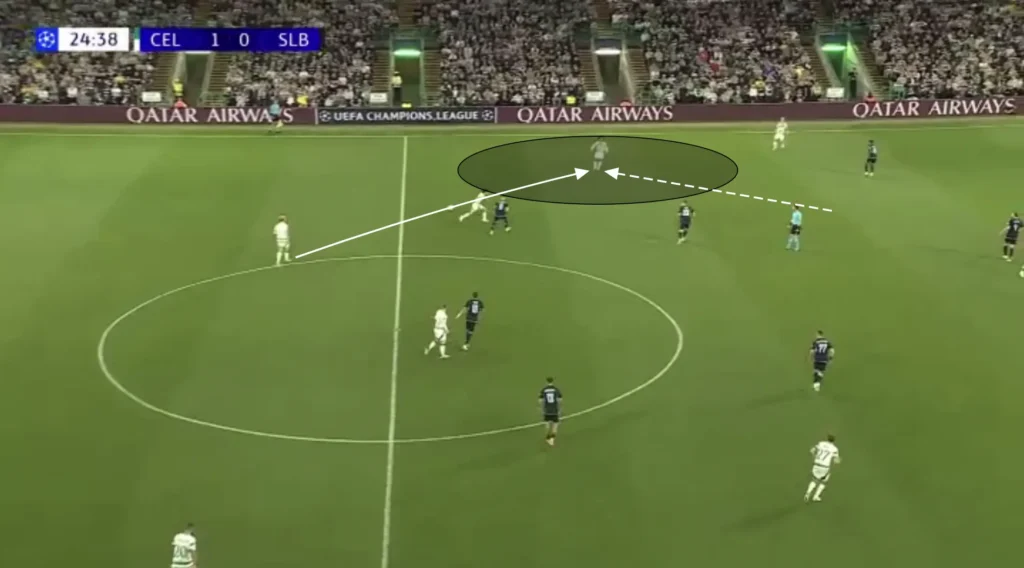
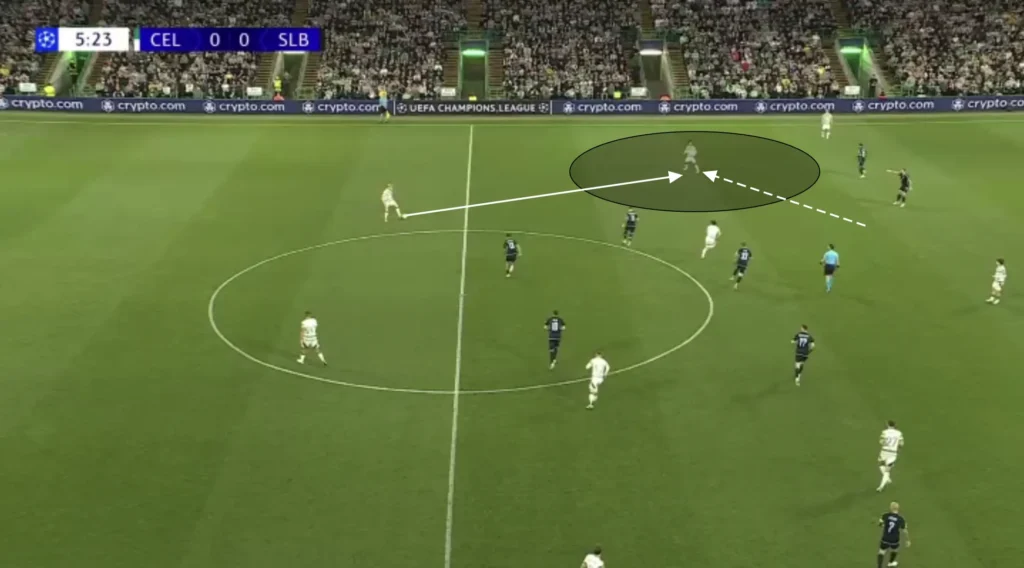
Linking with the Striker
In Brendan Rodgers’ tactical system, the striker, Kyogo Furuhashi, frequently drops deep during the build-up phase to create numerical superiority in midfield.
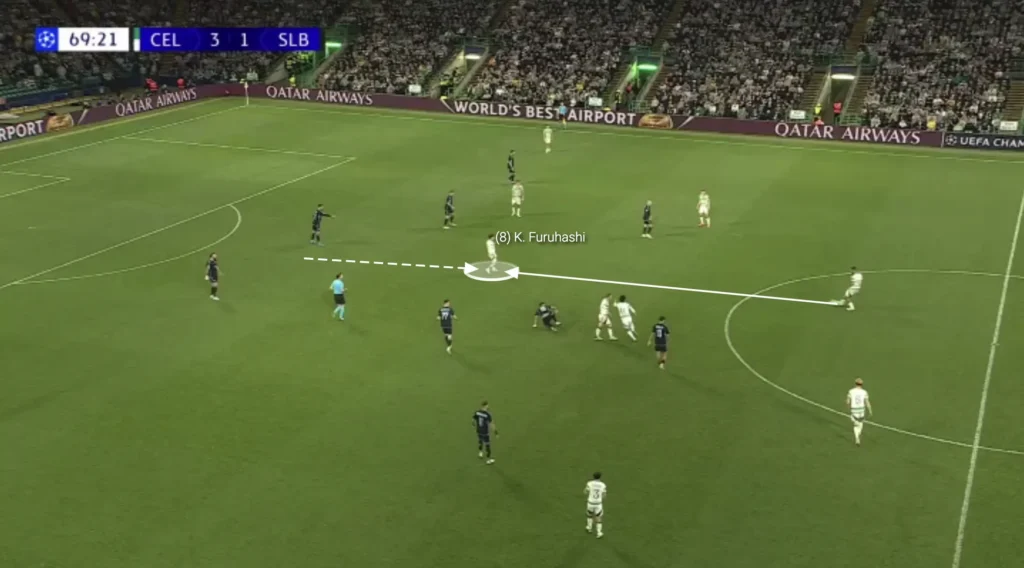
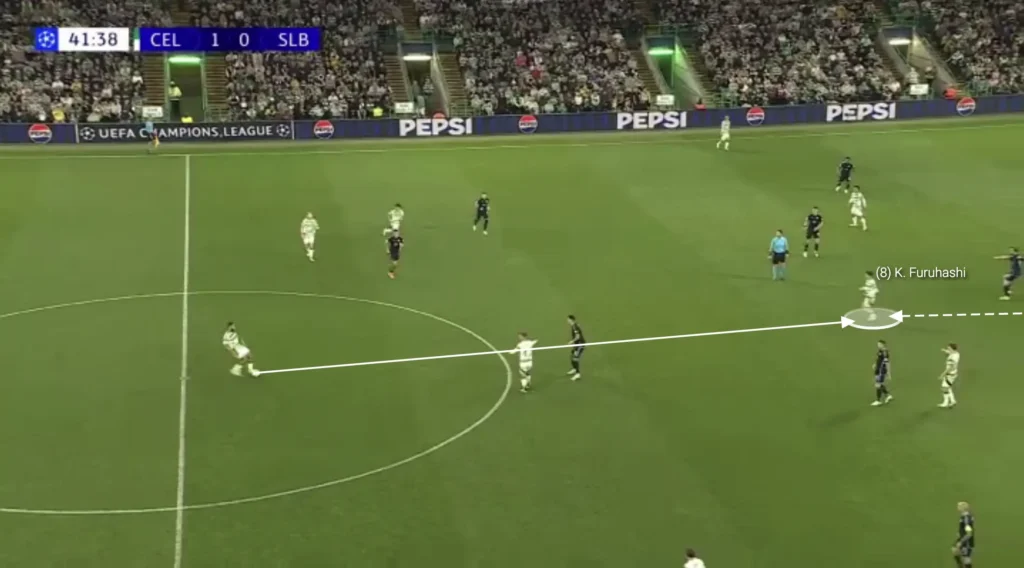
This movement is pivotal as it allows Furuhashi to act as a link between the midfield and the attack, drawing defenders out of position and creating space for his teammates to exploit. When the striker drops, Celtic unlock more ways of beating the opponent’s defense. They can pass the ball to the striker, who can find an attacking midfielder in the pocket or play a one-touch pass out to the winger.
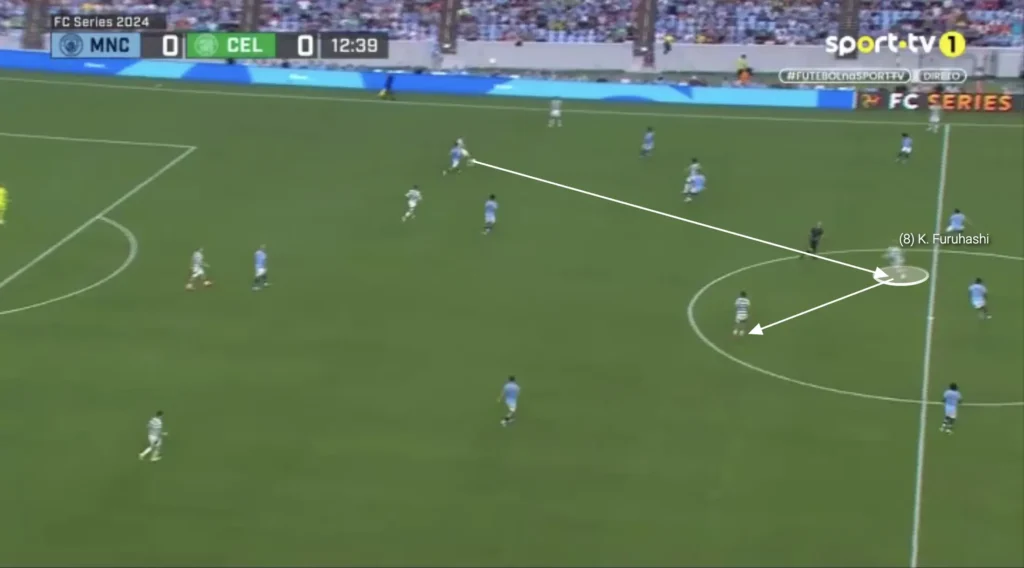
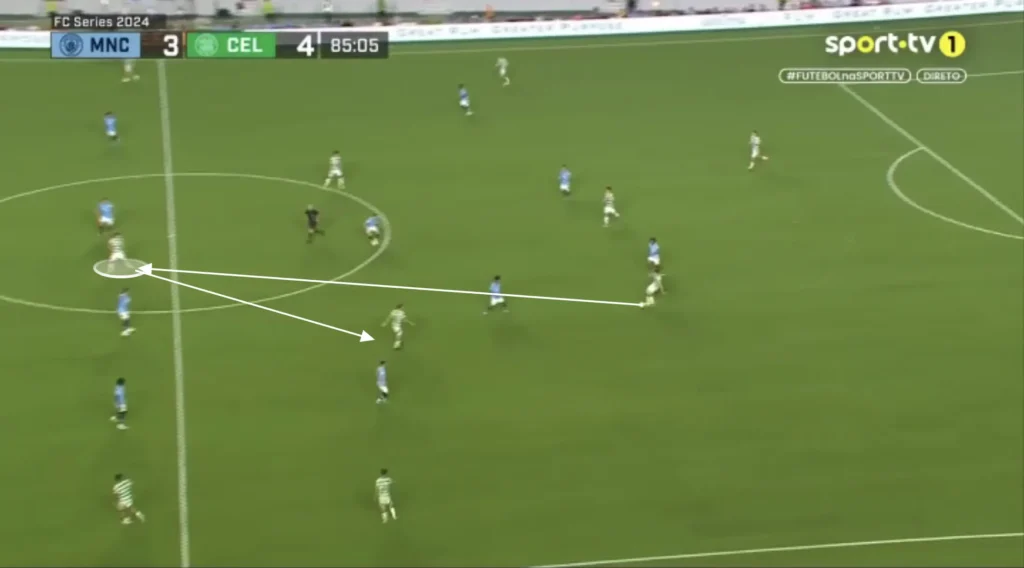
If an opposition center-back pushes up on the striker, the space in behind opens up. When that happens, Celtic will exploit the space in behind with runs from the wingers or attacking midfielders.
Final Third
Attacking the Half-Space
Rodgers’ players usually look to create chances by attacking the space between the opposition center-back and fullback. They primarily do this from the wide areas with underlaps from the attacking midfielders. When the winger receives the ball out wide he will attract the opposition fullback. This opens the space between the fullback and the center-back, which allows Celtic’s attacking midfielder to make the underlapping run into this space. The ball can be played to the underlapping player, who can cross the ball into the box or attack his defender in a 1v1 situation.
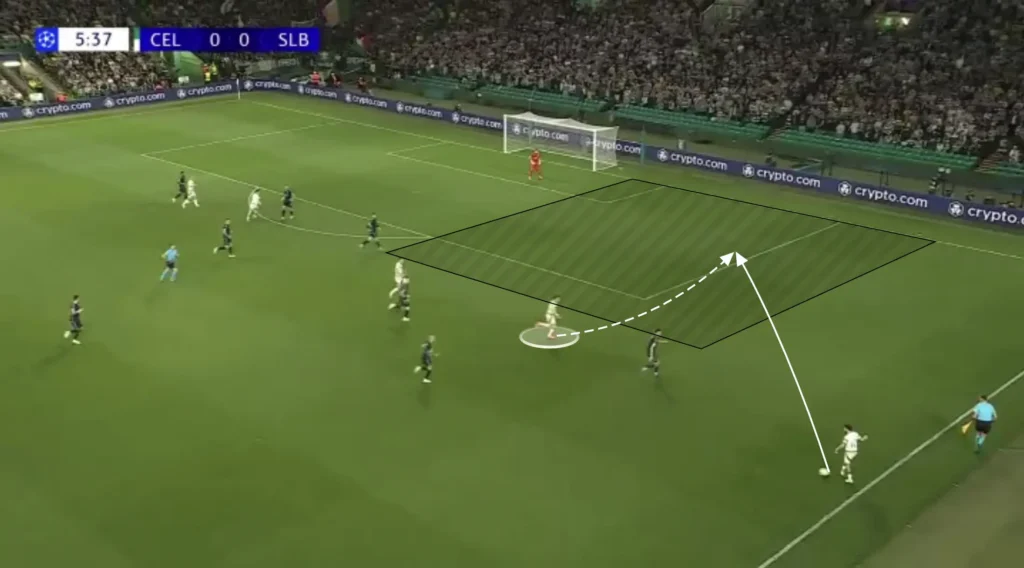
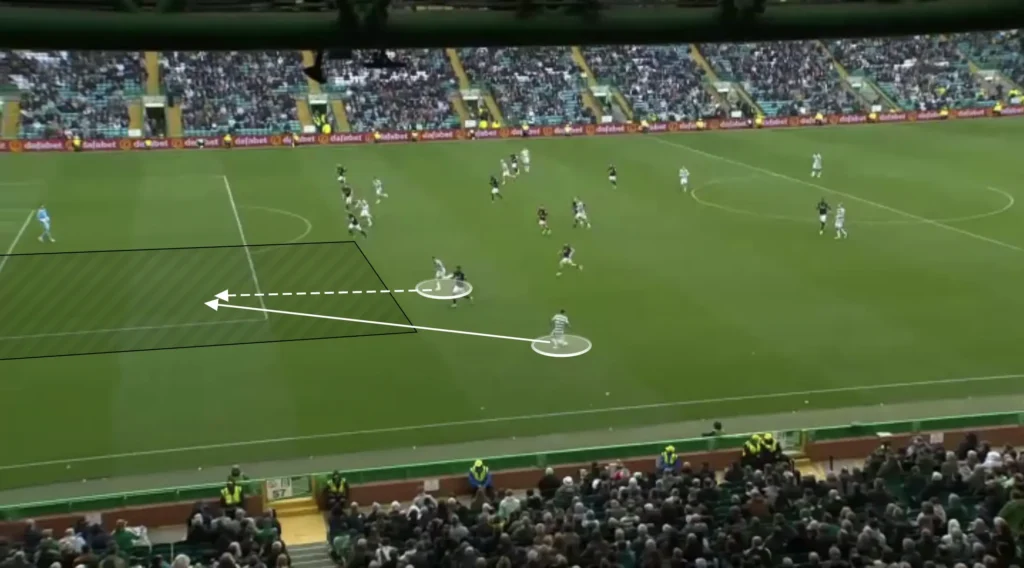
The winger does not have to play the ball to the underlapping player. The run from the attacking midfielder will often drag away an opposition defensive midfielder, which opens the space inside. The winger can take the ball inside and shoot or find a pass to a free player in front of the backline.
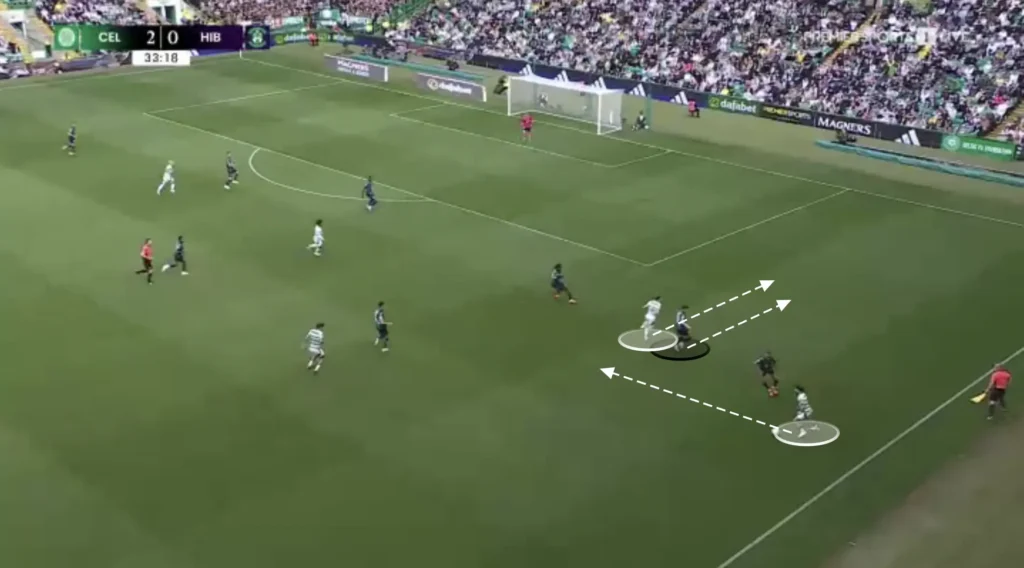
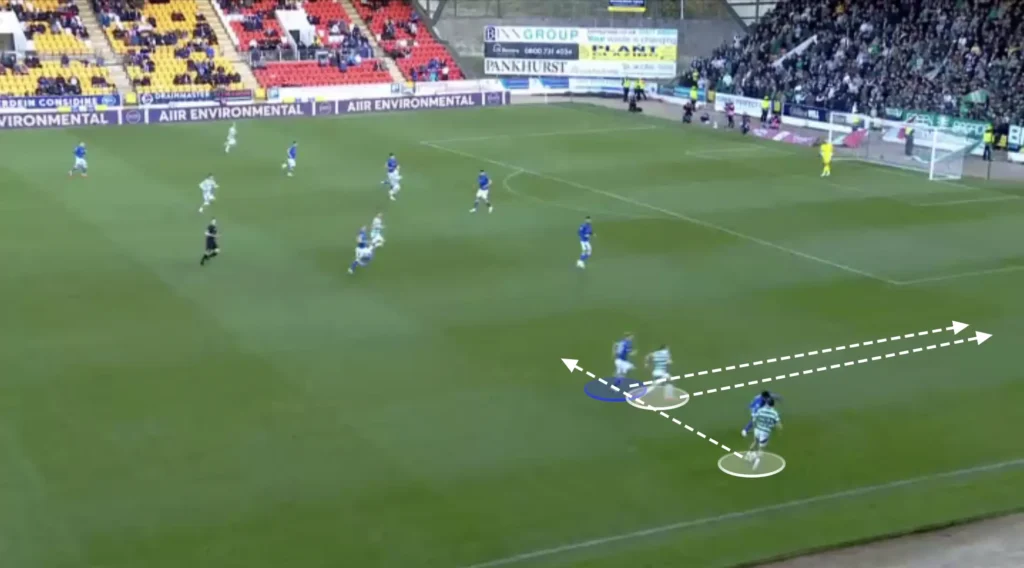
Second Runner
When an opposition player follows the attacking midfielder’s underlapping run, a different Celtic player, usually the inverted fullback, will make a new run into the space between the opposition center-back and fullback. The opposition’s holding midfielder, who followed the attacking midfielder’s run, will not be able to pick up this second run, meaning it will usually be uncontested. The winger can play the ball to the second runner, who can take it forward and shoot or find a teammate in the box.
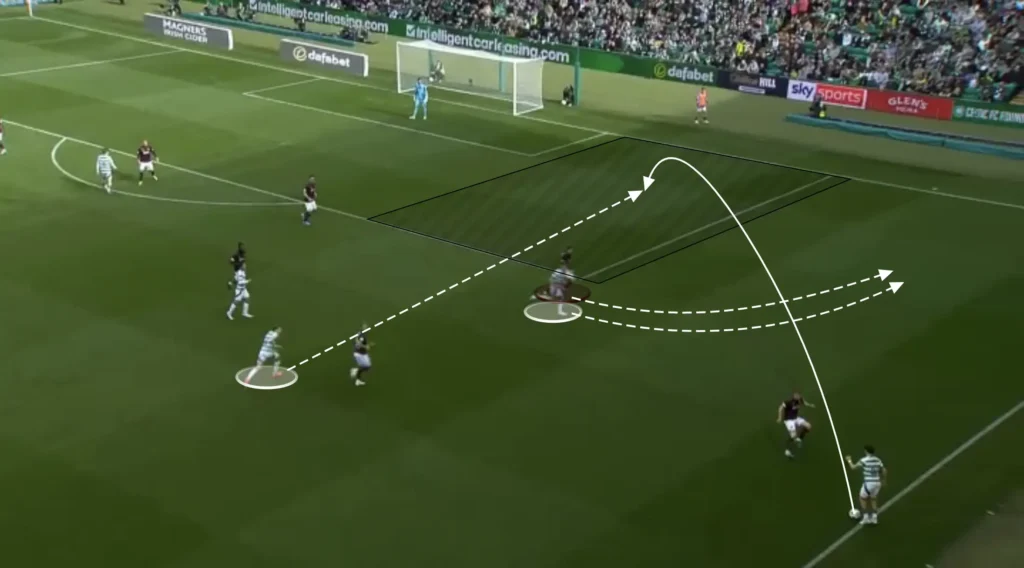
In this situation, the attacking midfielder makes the first underlapping run into the space between the opposition center-back and fullback. The opposition’s holding midfielder follows this run, enabling the winger to take the ball inside. Another midfielder now makes the run into the space between the opposition fullback and center-back, this time without the opposition’s holding midfielder there to cover the run. This allows the winger to play the ball to the running midfielder, who takes it forward and finds a teammate in the box.
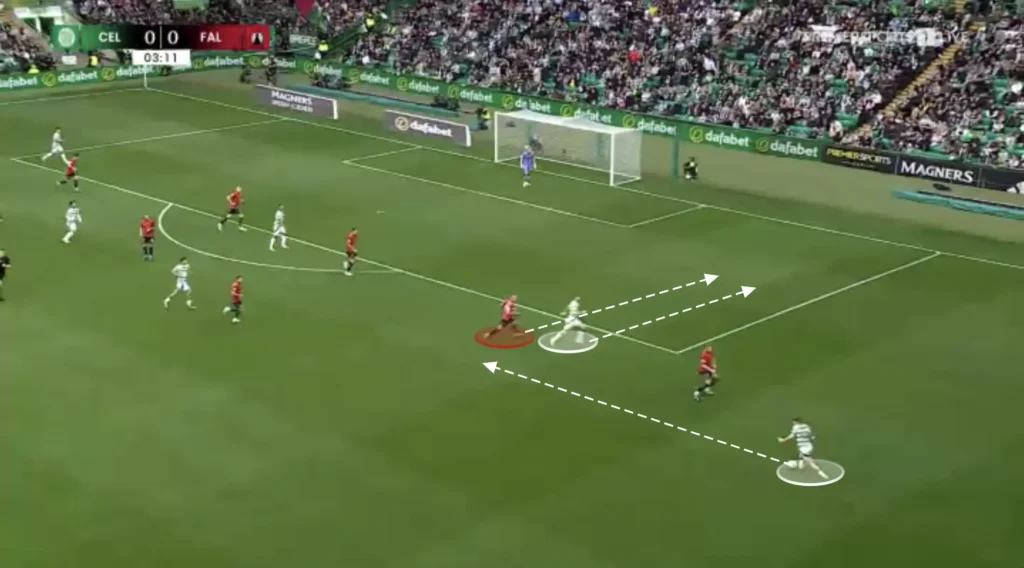
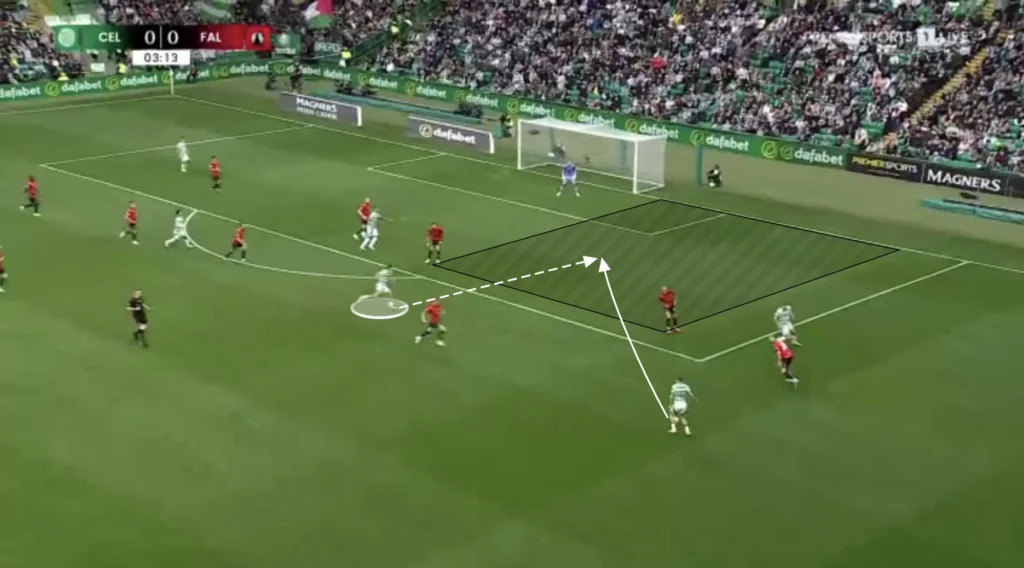
Overlaps
Celtic will also use overlaps to produce opportunities in the final third. When the winger gets the ball and the inverted fullback is nearby, the fullback can make the overlapping run, creating a 2v1 against the opposition fullback.
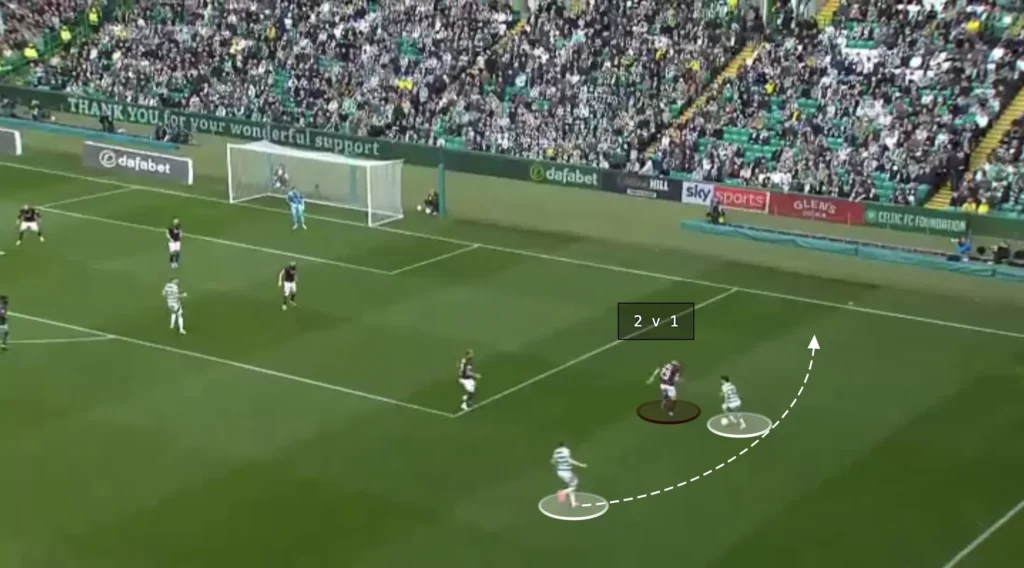
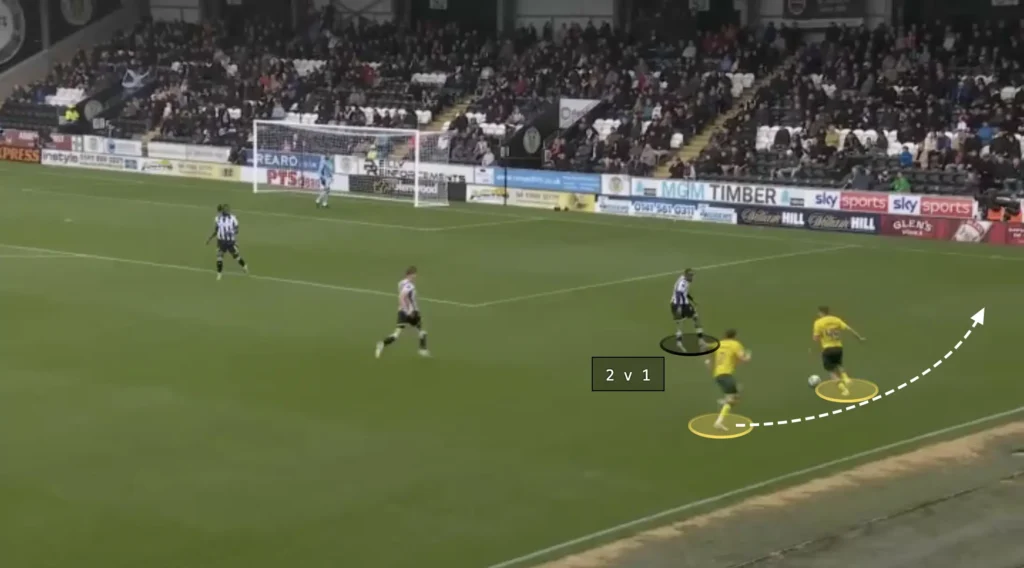
The overlap forces the defending fullback to make difficult decisions—either stick with the winger or follow the overlapping fullback. If the opposition fullback drops to cover the overlapping run, the winger could cut inside, taking a shot or combining with a midfielder. If the fullback covers the center, the ball can easily be played to the overlapping player, creating a crossing opportunity.
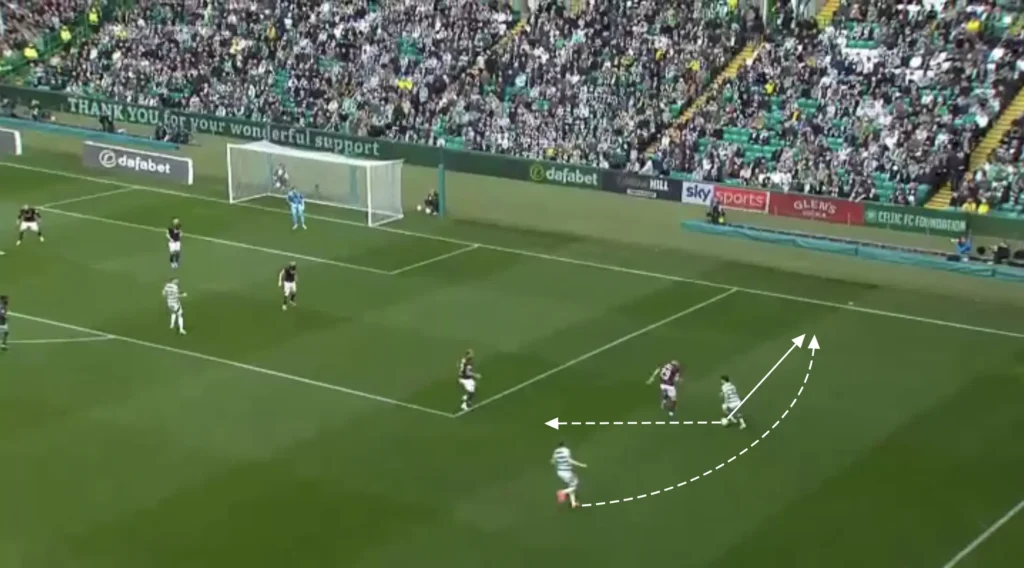
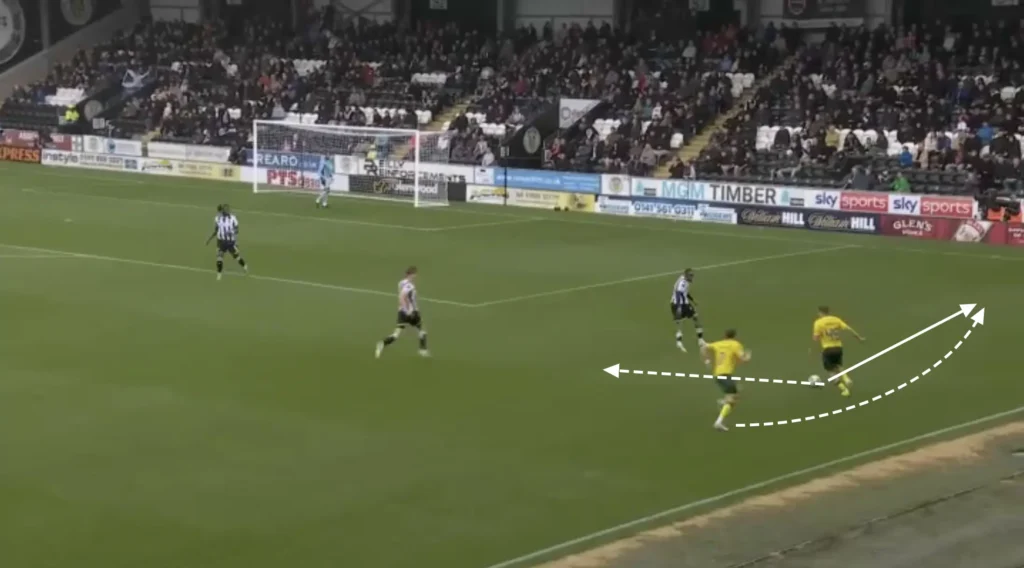
Many Players in the Box
The attacking midfielders and wingers look to make runs into the box when the ball is in the final third, often getting four or five players into these areas to create overloads. The numerical advantages in the box increase the chances of connecting with the cross, as more players present multiple targets for the crosser, making it harder for defenders to mark everyone effectively. Additionally, having multiple players in the box provides options for different types of finishes, whether it’s a header, volley, or a quick tap-in. It also allows for better positioning to react to second balls or rebounds, increasing the likelihood of capitalizing on any defensive errors.
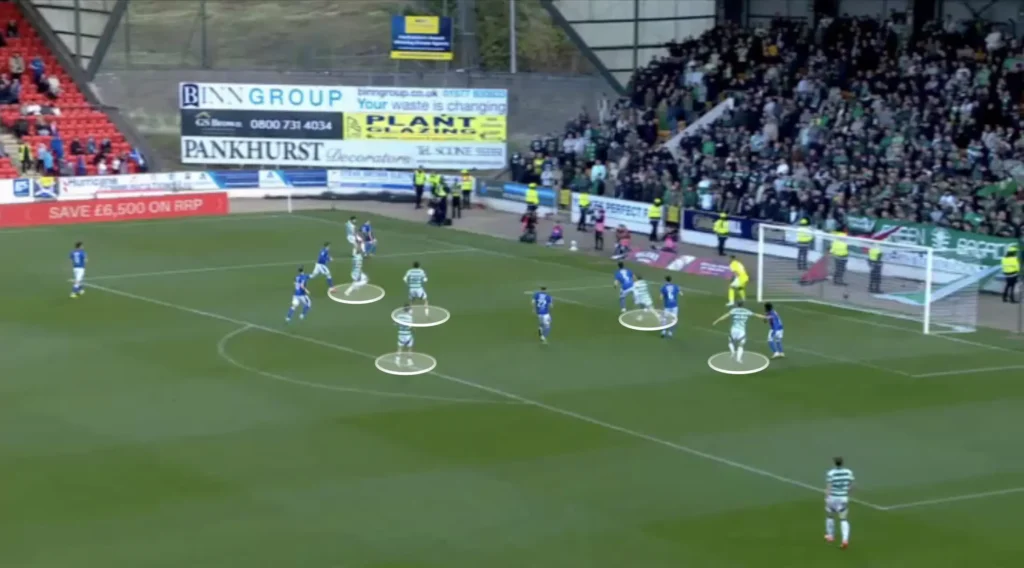
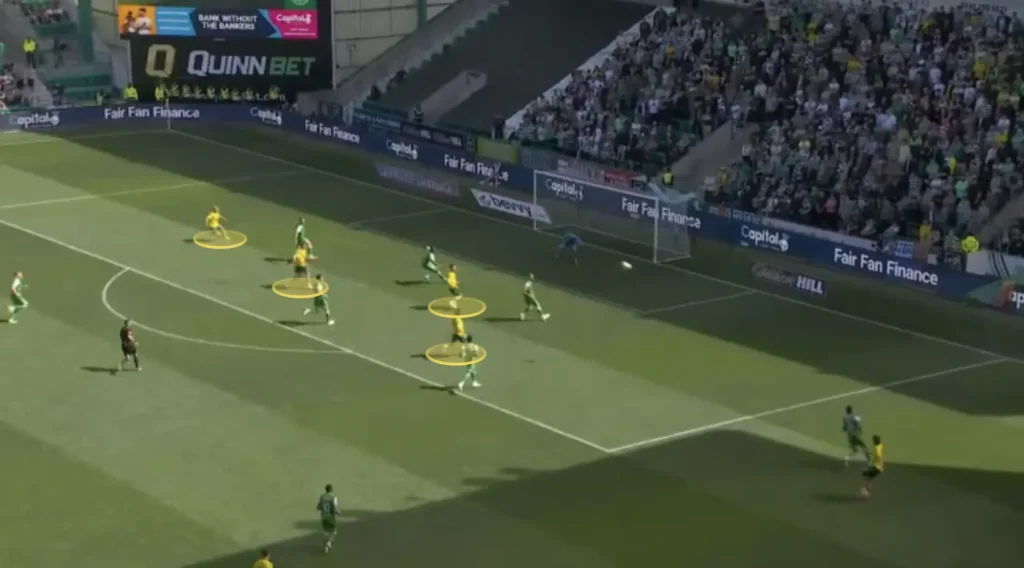
Rodgers also positions many players outside the box, ready for the second balls and cut-backs. Celtic will often create crossing opportunities, which pushes down the opposition’s defense and opens the space in front of the opposition’s backline. The holding midfielders can collect any loose balls or be found directly in these spaces with cut-backs, and from there, they can shoot or combine with an attacker to create goalscoring opportunities.
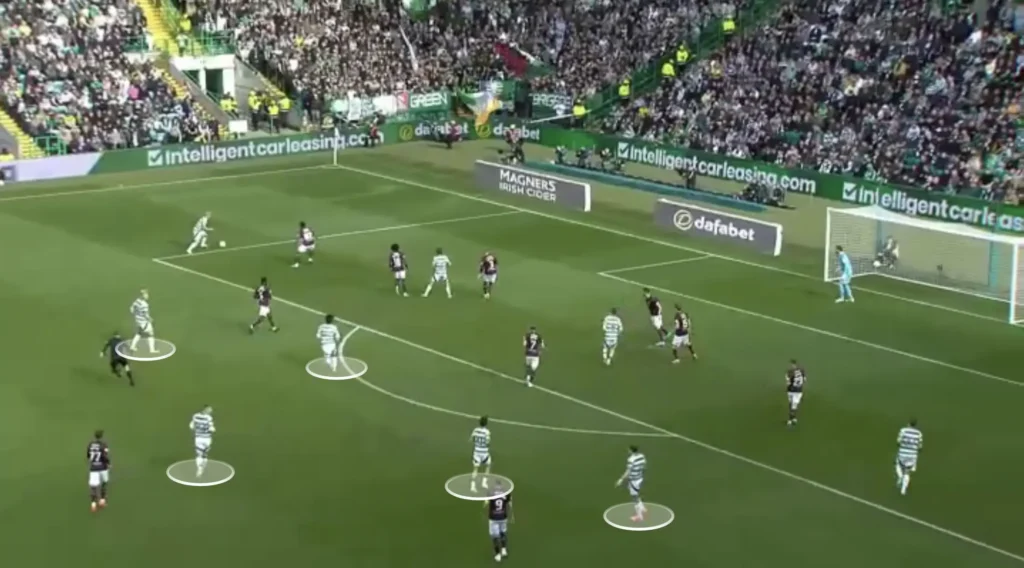
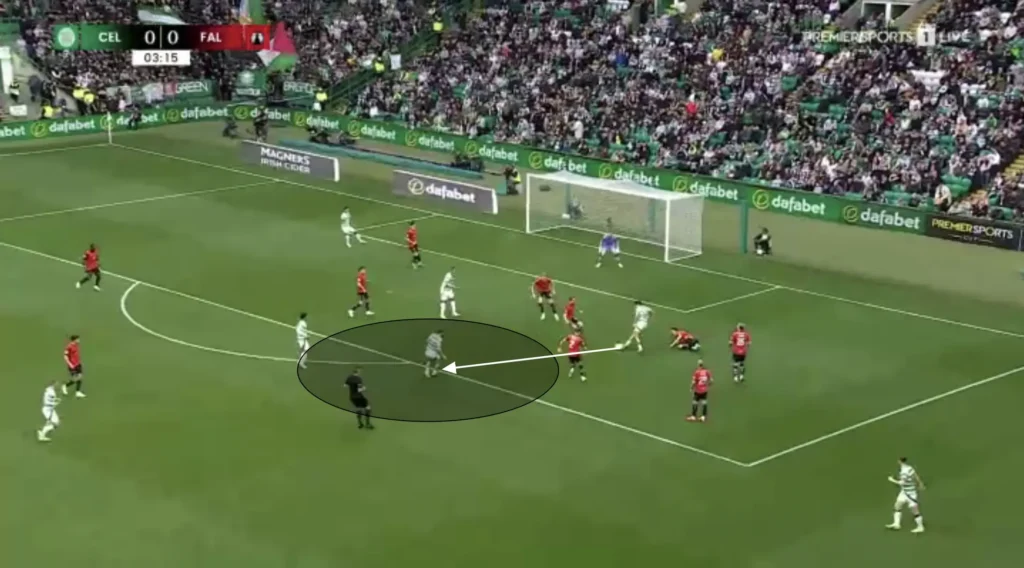
Defending
Low Press
Celtic’s base formation when defending is the 1-4-4-2 formation. They look to set up in a mid-block, always trying to close the center and force the opposition out wide. Defending in the 1-4-4-2 formation is all about balance, compactness, and discipline. The team defends in two compact lines of four, with the forwards positioned ahead of the midfield. The two forwards play a crucial role, not only as the first line of defense but also in initiating the team’s pressing strategy. Rodgers wants his team to stay compact without dropping too low, preferably closing the space between the midfield and backline.
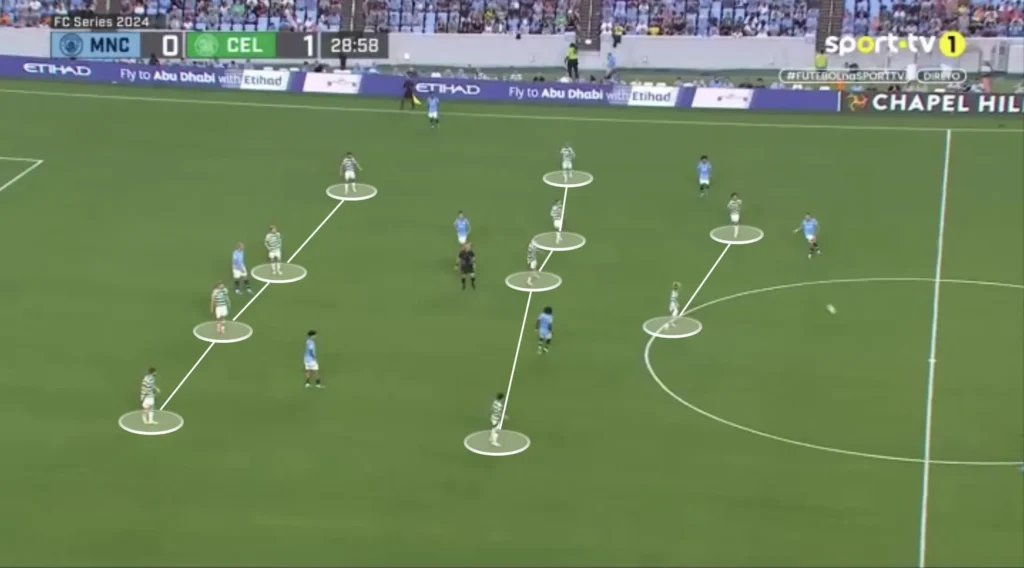
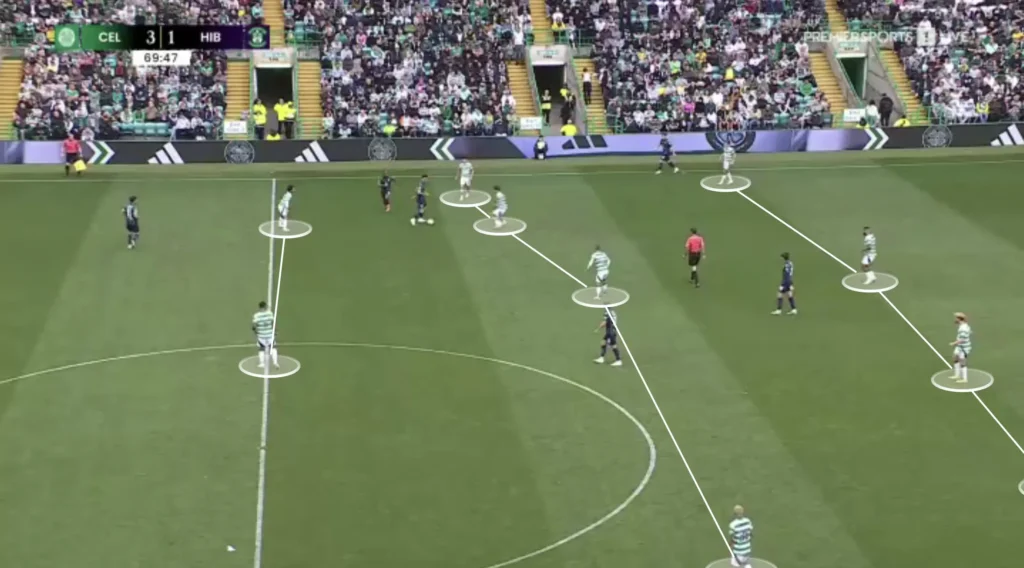
Squeezing the Pitch
Brendan Rodgers always wants his team to squeeze the pitch when defending. This means constantly pushing the team up as much as possible. Every time the opponent plays a slow, sideways pass or a back pass, Celtic’s first line of pressure pushes up, with the rest of the team following to stay compact. When the next pass comes, they push up even more, forcing the opponent back even more. They do this because it pushes the opponent further away from Celtic’s goal, making it harder to create chances.
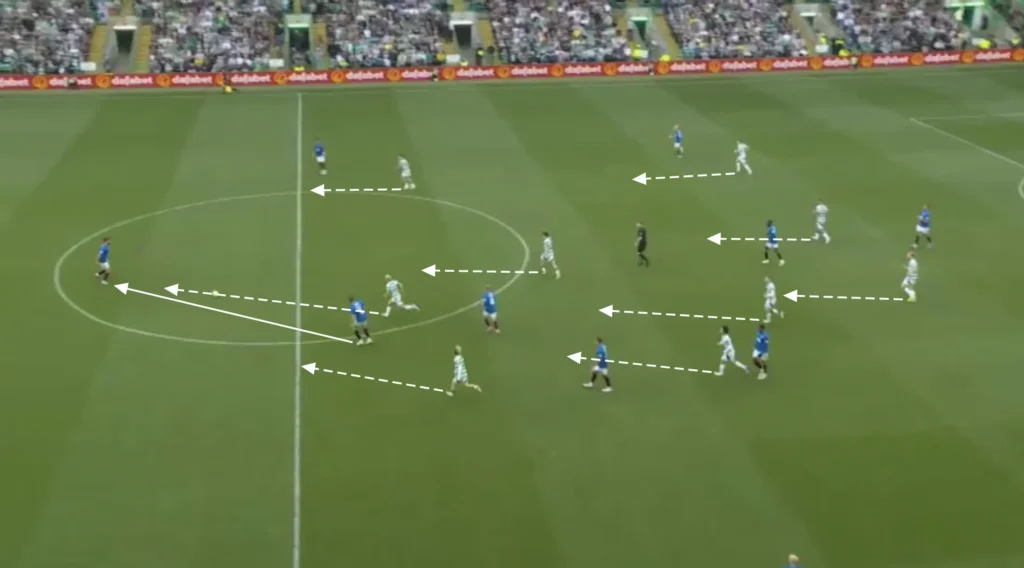
High Press
Rodgers usually wants to press the opposition high up the pitch. Their pressing structure will depend on the opposition, but they primarily press in their 1-4-4-2 formation. The strikers will try to close off one opposition center-back by making angled pressing runs, forcing the opposition to one side. The rest of the players will shift across and try to win the ball by using the touchline as an extra defender.
Celtic will be extremely aggressive and intensely press to win the ball when the ball gets played out to one of the opposition fullbacks. The ball-side winger pushes up on the ball-side opposition fullback, with the rest of the midfield shifting across to close down any passing options. The ball-side striker will try to stop the opposition from switching sides by pushing up on the ball-side center-back, while the far-side striker drops back on the opposition’s holding midfielder.
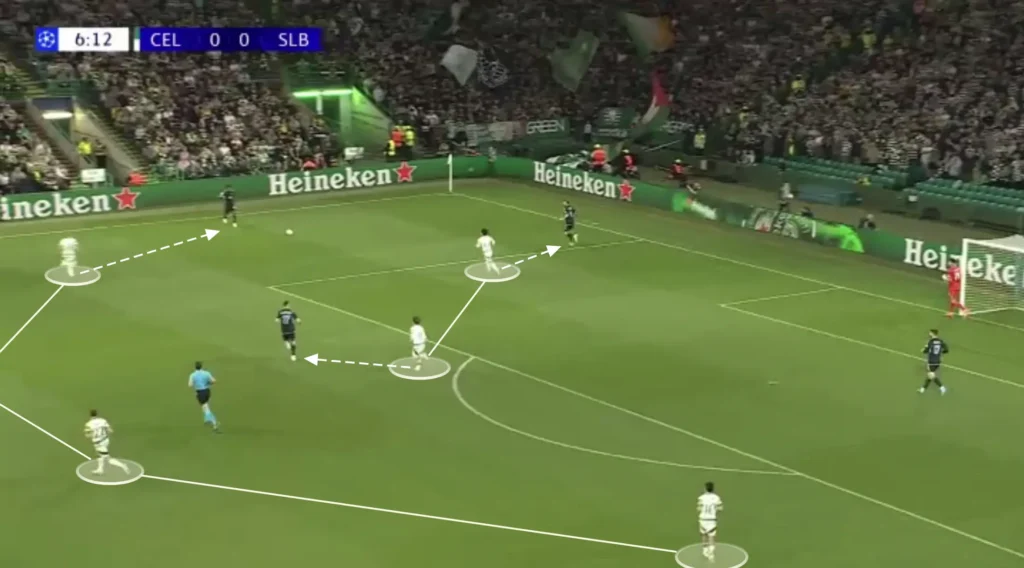
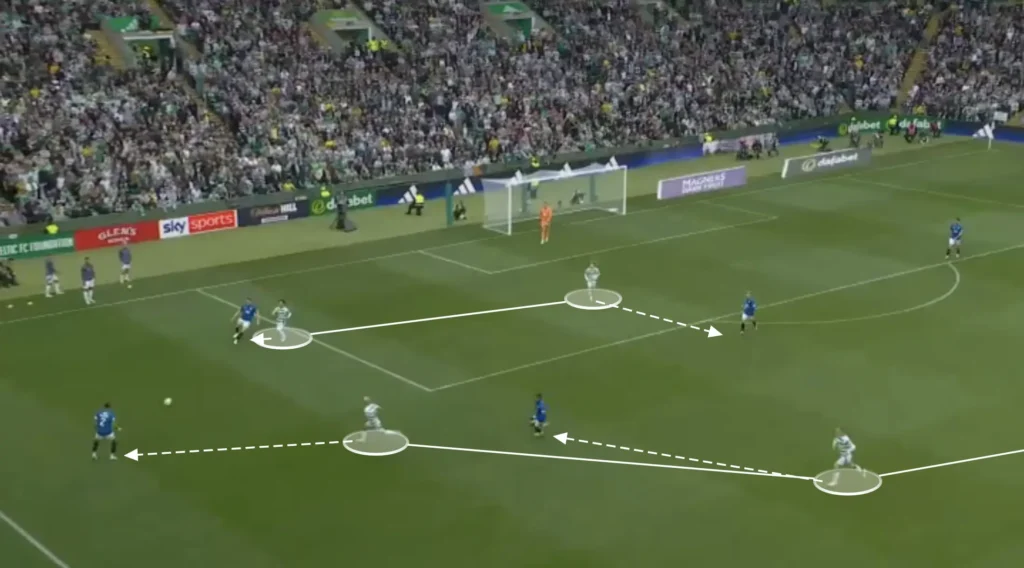
This system allows Celtic to press the opposition high up the pitch while having a numerical advantage against the opposition attackers, which gives them more control when defending long balls.
Final Thoughts
In conclusion, Brendan Rodgers’ tactical approach at Celtic showcases his ability to blend possession-based football with high-intensity pressing and dynamic movement. His focus on dominating possession, fluid attacking play, and building from the back allows Celtic to control games and break down opponents with precision. Defensively, his structured pressing system helps the team maintain pressure and win back possession quickly.
Rodgers’ tactical adaptability and focus on player development also play a crucial role in Celtic’s success under his leadership. His philosophy has transformed the team’s style of play, leaving a lasting impact on the club’s modern footballing identity.

Great stuff and a great site you’ve got